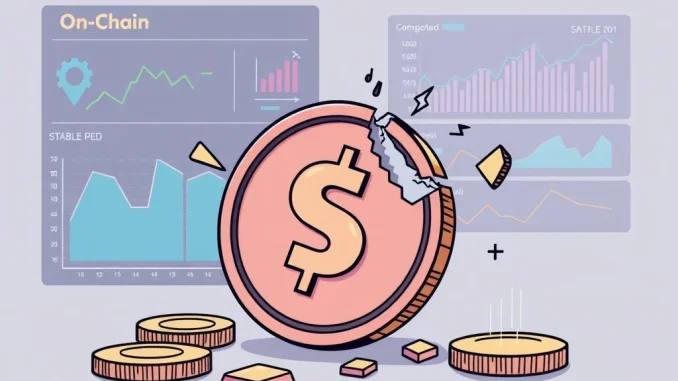
In the volatile world of cryptocurrency, stablecoins are often seen as anchors of stability, designed to maintain a steady value, usually pegged to the US dollar. However, recently, sUSD, a stablecoin within the Synthetix ecosystem, experienced a significant depeg, causing concern and discussion within the DeFi community. A new, insightful report from Parsec, a renowned crypto on-chain data analytics platform, has pinpointed the primary culprit behind this unexpected event: the SIP-420 governance proposal. Let’s delve into the details of Parsec’s research and understand how this SIP-420 governance proposal played a crucial role in the sUSD depeg.
Decoding the sUSD Depeg Event
The sUSD depeg is a critical event that highlights the inherent complexities and potential risks within decentralized finance (DeFi). When a stablecoin like sUSD loses its peg, it deviates from its intended value, typically $1 USD. This deviation can trigger a cascade of effects, impacting traders, investors, and the overall stability of the DeFi ecosystem. Parsec’s report meticulously examines the on-chain data and concludes that the SIP-420 governance proposal is not just a contributing factor, but the primary driver behind this recent instability. But what exactly is SIP-420, and how did it lead to the depeg?
SIP-420 Governance Proposal: Streamlining or Destabilizing?
The SIP-420 governance proposal was initially conceived as a mechanism to enhance the efficiency of the Synthetix network. It aimed to simplify the staking process for SNX holders by introducing a shared debt pool. This proposal allowed SNX stakers to delegate the minting of sUSD and the management of their debt into this communal pool. The intended benefits were clear: streamlined operations and potentially increased participation in staking. However, Parsec’s analysis reveals a significant unintended consequence. Before SIP-420, individual stakers were directly responsible for the debt associated with the sUSD they minted. This created a crucial ‘reflexive defense mechanism’ that inadvertently contributed to the stability of sUSD.
| Feature | Pre-SIP-420 | Post-SIP-420 |
|---|---|---|
| Debt Management | Individual Staker Responsibility | Shared Debt Pool |
| Risk Bearing | Individual Staker Bears Direct Risk | Risk Distributed Across Pool |
| Reflexive Defense Mechanism | Present (Individual Incentive to Maintain Peg) | Absent (Reduced Individual Incentive) |
The Erosion of the Reflexive Defense Mechanism
According to the Parsec report, the shift to a shared debt pool under SIP-420 has effectively eliminated the ‘reflexive defense mechanism’. Previously, if sUSD started to trade below its peg, individual stakers had a direct financial incentive to act and help restore the peg, as their personal debt was at stake. This self-correcting mechanism was a crucial, albeit perhaps unintentional, element of sUSD‘s stability. With the implementation of SIP-420, this individual accountability is diluted. As the debt is now communal, stakers no longer bear the immediate, direct risk when sUSD deviates from its peg. Parsec’s report poignantly states, “A reflexive defence mechanism which was once in place is now gone,” highlighting this critical shift in the protocol’s dynamics.
Implications for Synthetix and the Future of sUSD
The findings of the Parsec report present a significant challenge for Synthetix and the future stability of sUSD. The removal of the reflexive defense mechanism necessitates a re-evaluation of the stability mechanisms for sUSD. Synthetix developers and the community will need to consider new strategies to ensure the stablecoin maintains its peg effectively. This could involve exploring alternative incentive structures, implementing enhanced monitoring systems, or even revisiting aspects of the SIP-420 governance proposal itself. The response of Synthetix to this situation will be crucial in determining the long-term viability and trustworthiness of sUSD within the DeFi ecosystem.
Broader Lessons for DeFi and Stablecoin Governance
The sUSD depeg incident, attributed to the SIP-420 governance proposal, offers valuable lessons for the broader DeFi space, particularly concerning stablecoin governance and protocol upgrades. It underscores the importance of rigorous testing and comprehensive risk assessment before implementing significant governance changes. Even proposals designed to improve efficiency and streamline processes can have unintended consequences that impact the fundamental stability of a protocol. For DeFi projects in general, this event serves as a reminder to:
- Conduct thorough impact assessments: Before implementing governance proposals, especially those that alter core economic mechanisms, conduct in-depth analyses of potential risks and unintended consequences.
- Prioritize security and stability: While efficiency and user experience are important, the security and stability of the protocol should always be paramount, particularly for stablecoins.
- Maintain community vigilance: Encourage active community participation in governance and foster a culture of vigilance in monitoring protocol behavior and identifying potential vulnerabilities.
- Iterative development and adaptability: Embrace an iterative approach to development, allowing for adjustments and refinements based on real-world observations and feedback, as demonstrated by the sUSD depeg event.
Conclusion: A Vital Case Study in DeFi Evolution
The sUSD depeg, driven by the implications of the SIP-420 governance proposal, is more than just a market fluctuation; it’s a critical learning opportunity for the entire DeFi ecosystem. It highlights the delicate balance between decentralized governance, protocol efficiency, and the paramount need for robust and resilient stability mechanisms. As DeFi continues its rapid evolution, understanding and internalizing the lessons from events like the sUSD depeg will be essential in building a more secure, reliable, and ultimately, more trustworthy decentralized financial future. The spotlight is now on Synthetix, and the crypto community will be watching closely to see how they navigate this challenge and reinforce the stability of sUSD.



